
- Topics 1527
- Industrial 59
- Troubleshooting Guides 31
- Restaurant Management 140
- Bar Management 66
- Catering Tips 38
- Bakery Management 47
- Food Trucks & Concessions 47
- Advertising & Marketing 40
- Eco-Friendly Tips 12
- Facility Layout & Design 50
- Coffee Shop Tips 31
- Installation & Maintenance 59
- Janitorial & Pest Control 33
- Safety & Sanitation 109
- Startup Tips 113
- Menu Design 11
- Kitchen & Cooking Tips 103
- Hospitality Management 24
- Pizza & Sandwich Shop Tips 30
- Smallwares 40
- Food Prep 101
- Tabletop Items 19
- Disposables 26
- Calculators & Tools 8
- Consumables 70
- Warewashing & Laundry 21
- Cooking Equipment 101
- Food Storage & Refrigeration 54
- Beverage Equipment 39
- Office Supplies 5
Choosing the right commercial oven is a critical decision for any foodservice business, as it directly impacts the quality, efficiency, and consistency of your culinary output. With a wide array of oven types available, ranging from deck and conveyor ovens to combi and rotisserie ovens, understanding their unique features and applications is essential to making an informed choice. Whether you're running a bakery, a pizzeria, or a fine dining restaurant, this guide will help you navigate the options and select the best commercial oven to elevate your kitchen's performance and meet your business goals.
Shop All Commercial Ovens
What Is a Commercial Oven?
A commercial oven is a piece of staple kitchen equipment designed for high-volume cooking and baking in restaurants, bakeries, catering businesses, and other foodservice establishments. Unlike residential ovens, commercial ovens are built to withstand heavy use and are equipped with advanced features to meet the demands of a professional kitchen environment. Not only are commercial ovens equipped with powerful heating elements or burners that provide consistent and even heat distribution, but they also often have extra safety features and advanced temperature controls.
Types of Commercial Ovens
Commercial ovens come in several different styles, some being designed for rapid cooking while others are made to both cook and hold food items for extended periods. By familiarizing yourself with the different types of commercial ovens on the market, you can make an informed purchasing decision tailored to your commercial kitchen's requirements.
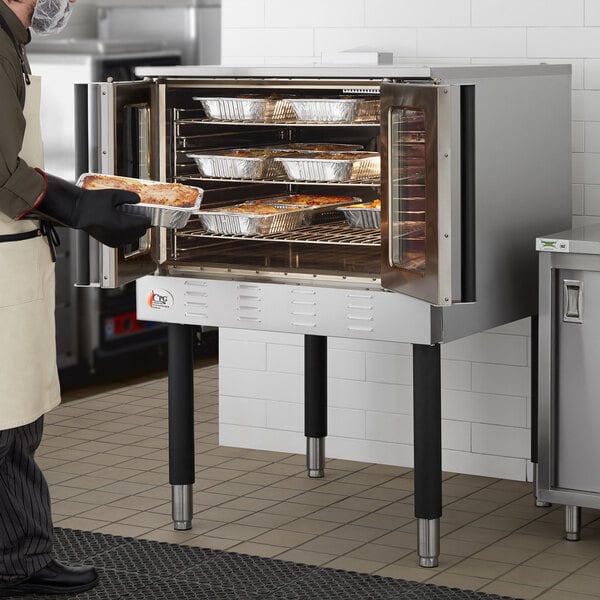
Convection ovens are versatile cooking appliances that evenly cook food using a fan and exhaust system that circulates hot air throughout the cooking chamber. This technology ensures consistent temperatures and faster cooking times compared to traditional ovens. Convection ovens are widely used in commercial kitchens for baking, roasting, and reheating a variety of foods, including pastries, meats, vegetables, and casseroles. They are prized for their ability to produce consistent results, making them ideal for high-volume foodservice operations.
- Provides even cooking
- Faster cook times
- Energy efficient
Convection Oven vs Conventional Oven
Convection ovens use fans to circulate hot air, while conventional ovens rely on radiant heat from heating elements. Due to this, convection ovens tend to cook faster due to the even heat distribution, often reducing cooking times.
Convection ovens are better for achieving consistent browning and crisping, making them ideal for baked goods and roasted items. Conventional ovens, on the other hand, are preferred for delicate items like souffles or custards that may not benefit from moving air.
Where Should a Commercial Convection Oven Be Located?
When considering where to place a commercial convection oven in your kitchen, it is important to choose a location that allows for proper ventilation and easy access for loading and unloading. Ideally, the oven should be placed away from walls or other equipment to allow for proper airflow and prevent overheating.
Commercial Convection Oven Requirements
Convection ovens require adequate space around the oven for air circulation, proper electrical connections to meet the oven's power needs, and regular maintenance to keep the oven in good working condition. Additionally, it is crucial to follow the manufacturer's recommendations for installation and usage to maximize the oven's efficiency and lifespan.
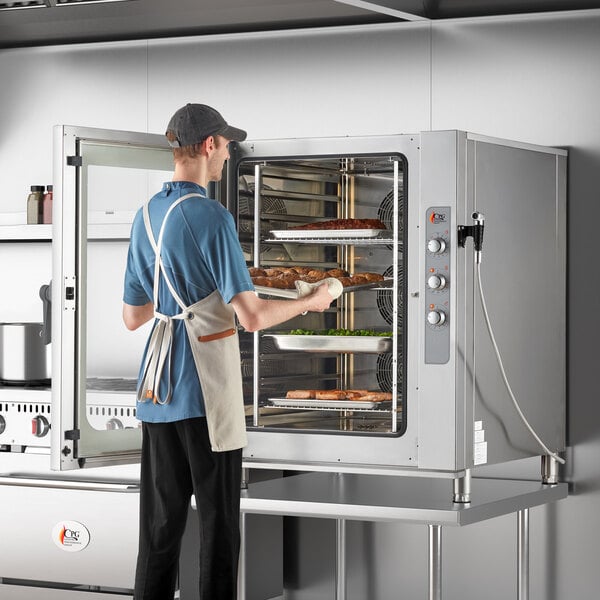
Combi ovens are a type of equipment that combines the functions of a steamer and a convection oven in one unit. Different types of combi ovens allow for cooking with steam, hot air, or a combination of both, providing chefs with the flexibility to prepare a wide range of dishes efficiently.
- Can steam, bake, roast, grill, and even smoke food
- Cooks food faster than traditional ovens while using less energy
- Offers precise temperature and humidity control
Where Should a Commercial Combi Oven Be Located?
When considering the placement of a commercial combi oven in a kitchen, it is essential to choose a location that ensures easy access for kitchen staff while optimizing workflow. Ideally, the oven should be positioned near other cooking equipment to streamline the cooking process and reduce the need for excessive movement between stations.
Commercial Combi Oven Requirements
These ovens need adequate ventilation to release steam and heat generated during the cooking process. Additionally, they require a dedicated water connection for the steam function and a power source that meets the oven's electrical requirements. Proper maintenance, including regular cleaning and descaling, is crucial to ensure the longevity and performance of a commercial combi oven.
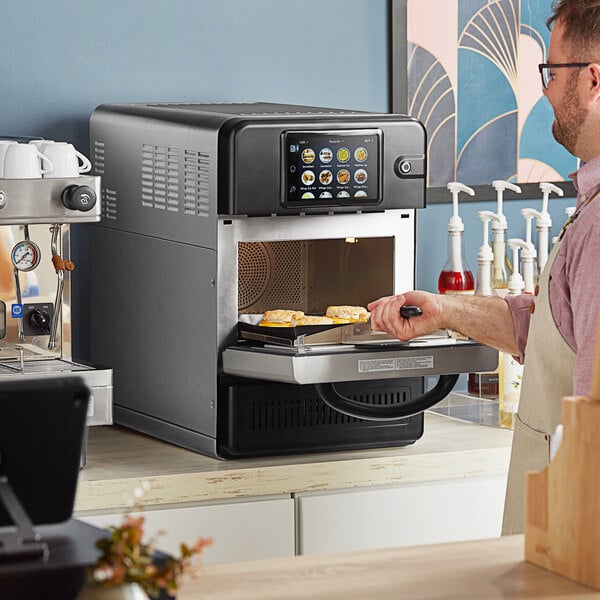
High-speed ovens, also known as rapid-cook ovens, combine multiple heat transfer methods like powerful convection, microwave, and radiant heat technologies to cook food quickly and evenly. Commercial high-speed ovens are ideal for busy kitchens that require fast cooking times without sacrificing quality.
- Rapidly cooks food
- Provides even cooking and heat retention
- Great for busy kitchens and quick-service restaurants
Where Should a Commercial High-Speed Oven Be Located?
When considering where to place a commercial rapid-cook oven in your kitchen, it is essential to prioritize accessibility and workflow to effectively capitalize on the ovens' ability to cook food quickly. These ovens should be located in a central area where kitchen staff can easily access them, reducing the time to prepare and cook menu items even further. Placing the oven in a convenient location can also help streamline the cooking process and improve overall kitchen efficiency.
Commercial High-Speed Oven Oven Requirements
These ovens typically require a dedicated power source, so it is essential to have the necessary electrical connections in place before installation. Additionally, proper ventilation is crucial to prevent overheating and maintain a safe working environment.
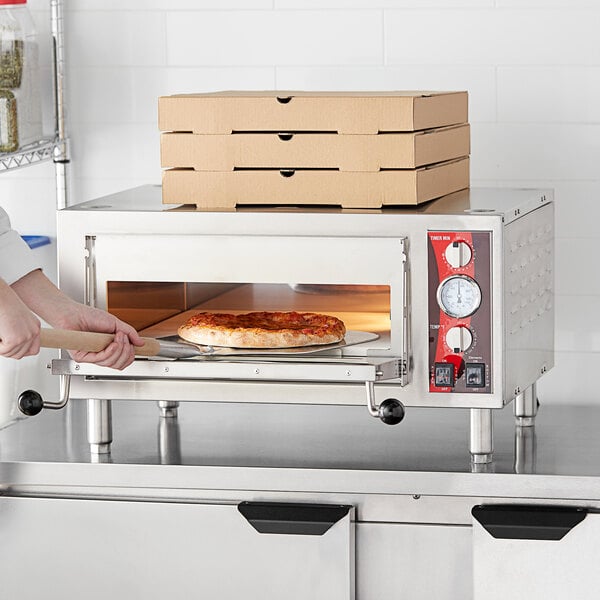
Pizza ovens are specialized cooking appliances designed to produce high-quality pizzas with consistent results in a commercial setting. These ovens are engineered to achieve high temperatures, enabling quick cooking times and the creation of crispy crusts and evenly melted toppings. Pizza ovens are also versatile and can be used to cook other items like flatbreads, calzones, or roasted vegetables, making them a staple in pizzerias and restaurants.
- Can reach high temperatures quickly
- Typically bakes multiple pizzas at once
- Designed to distribute heat evenly throughout the cooking chamber
Where Should a Commercial Pizza Oven Be Located?
Position the oven close to where pizzas are assembled to minimize the distance between preparation and cooking. This arrangement improves efficiency and reduces the risk of accidents during transport.
Due to the high heat output, avoid placing your oven in close proximity to customer seating or waiting areas. Additionally, you should locate the oven under or near a proper ventilation system to manage heat and smoke, especially for wood-fired or gas-powered models.
Commercial Pizza Oven Requirements
The surrounding area and installation surface of your pizza oven must be heat-resistant to prevent damage or fire hazards. Some types of pizza ovens, particularly wood-fired and brick ovens, may need additional insulation to retain heat efficiently and protect surrounding equipment. A dedicated hood system is typically required to manage smoke, grease-laden vapors, and heat output. Wood-fired ovens may require smoke filtration systems to comply with local air quality regulations, especially in urban or indoor settings.

Cook and hold ovens are designed to cook food at precise temperatures and then hold it at a safe serving temperature until it is ready to be served. They are ideal for busy commercial kitchens, catering operations, and buffet-style restaurants where food needs to be cooked in advance and kept warm for extended periods. These ovens are commonly used for slow-cooking meats, roasting vegetables, and holding cooked dishes such as soups, stews, and sauces.
- Can keep food at serving temperatures after cooking
- Helps comply with food temperature safety standards
- Provides the flexibility to prepare and hold multiple types of food
Where Should a Commercial Cook and Hold Oven Be Located?
To enhance efficiency in food preparation, consider locating the commercial cook and hold oven near food preparation areas. This will facilitate a smooth transition from holding to plating, allowing for quick and convenient assembly of dishes. The location of your commercial cook and hold oven should be planned within the overall kitchen layout to streamline workflow and minimize unnecessary movement of staff. Ideally, place the oven in a covenient area that is easily accessible to kitchen staff but does not obstruct the flow of other kitchen activities.
Commercial Cook and Hold Oven Requirements
Before installation, consult the manufacturer's specifications to determine the specific voltage and phase requirements of your type of cook and hold oven. Confirm your kitchen's electrical system can accommodate the oven's power needs to prevent electrical issues and ensure consistent performance.
Check that the oven fits comfortably and allows for proper airflow around the unit. Install a ventilation system that meets local building codes and manufacturer recommendations to prevent the buildup of harmful fumes and ensure optimal air quality in the kitchen.
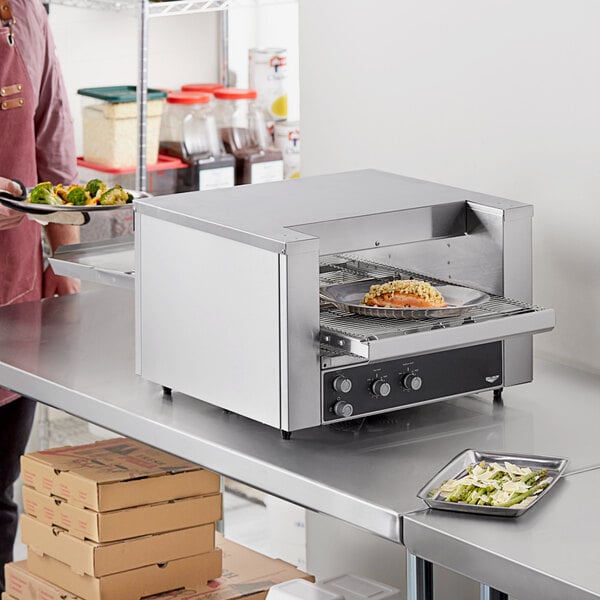
Conveyor ovens are commercial cooking appliances designed for efficiency and consistency in high-volume kitchens. These ovens feature a conveyor belt that moves food through a heated chamber, cooking it evenly with radiant or forced-air heat. The conveyor belt ensures uniform cooking, making these ovens ideal for repetitive tasks such as baking pizzas, toasting bread, or reheating pre-cooked items.
- Handles large quantities of food at once
- Produces a high volume of food in a short amount of time
- Conveyor belt helps eliminate cooking hot spots
Where Should a Commercial Conveyor Oven Be Located?
Position conveyor ovens in line with the assembly or preparation area to streamline operations. For example, in a pizzeria, the oven should be situated near the pizza prep station and within reach of the serving area. Adequate clearance around the unit ensures safety and ease of access for cleaning and maintenance. Additionally, consider placing the oven in a ventilated zone to manage heat output and maintain comfort in the kitchen.
Commercial Conveyor Oven Requirements
Conveyor ovens have a belt system that requires clear space at both the entry (load) and exit (unload) points. Operators need unhindered access to these areas to load raw food items and remove cooked items efficiently. In tight spaces, this aspect can affect workflow and safety, so extra planning is necessary.
Conveyor ovens output food continuously, which means space for a cooling or staging area near the oven exit is often required. This prevents workflow bottlenecks and ensures the food can be safely handled or transferred to serving areas.
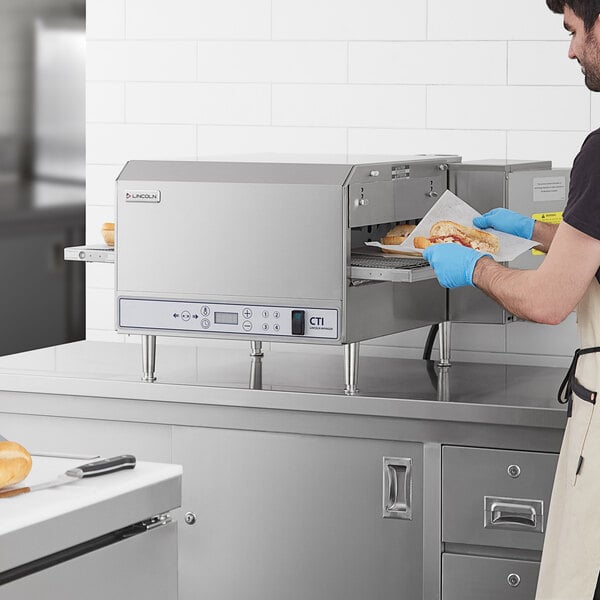
A type of conveyor oven, impinger ovens use a high-velocity airflow system to evenly distribute heat and cook food quickly. This technology allows for faster cooking times compared to traditional ovens, making them ideal for high-volume establishments.
Like other conveyor ovens, the key feature of impinger ovens is their conveyor belt system, which moves the food through the cooking chamber at a consistent speed. This ensures that each item receives the same amount of heat exposure, resulting in uniform cooking throughout the batch. Impinger ovens are versatile and can be used to bake a variety of items, including pizzas, sandwiches, and pastries.
- Compact design makes them ideal for establishments with limited space
- High-velocity air jets significantly speed up cooking times
Where Should a Commercial Impinger Oven Be Located?
When deciding where to place your impinger oven, confirm there is enough clearance around the oven to prevent fire hazards and allow for maintenance and cleaning. Additionally, consider factors such as floor stability and weight-bearing capacity to prevent accidents or damage to the equipment. Electric commercial impinger ovens require a significant amount of power to operate efficiently, so you need to make sure there is easy access to the necessary electrical outlets and that the electrical infrastructure can support the oven's power requirements.
Impinger Oven vs Conveyor Oven
Impinger ovens use high-velocity air jets to project heat onto food, significantly speeding up cooking times. The focused airflow ensures even cooking and a crispy finish, making them ideal for establishments that have small menus and prioritize speed, such as pizzerias or fast-food outlets.
Standard conveyor ovens rely on consistent radiant heat to cook food as it travels through the chamber. They are simpler and better suited for handling a wide selection of menu items but may not achieve the same crispiness or speed as an impinger oven.
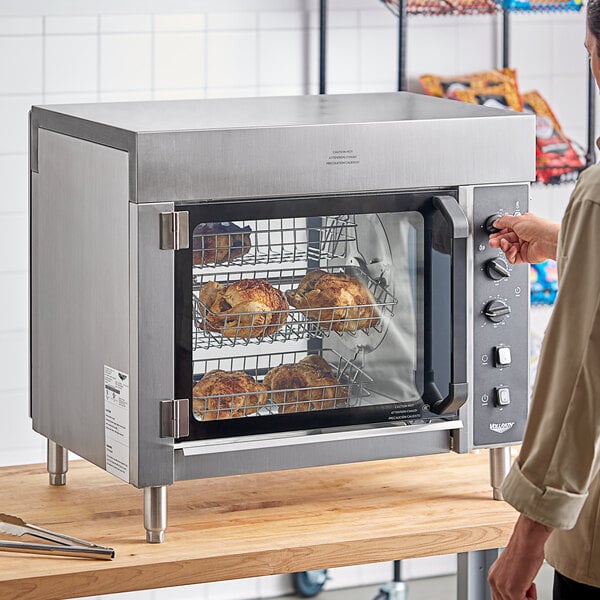
Rotisserie ovens are cooking equipment designed to roast meats, particularly poultry, evenly by rotating them on spits or baskets inside the oven chamber. This rotation ensures consistent exposure to heat, resulting in juicy interiors and crispy exteriors. High-quality rotisserie ovens are popular in restaurants, delis, and grocery stores that offer roasted chicken, ribs, or other specialty items. They come in various configurations, including countertop models and freestanding units, and may be powered by electricity, gas, or infrared heat.
- Rotating spit helps to evenly cook and baste the meat
- Typically have a compact, space-saving design
- Provides an eye-catching display
Where Should a Commercial Rotisserie Oven Be Located?
Rotisserie ovens should be located near the food preparation area where meats are seasoned and prepped, and close to the serving or display area to minimize handling time. In establishments where rotisserie items are part of customer-facing operations, the oven is often placed in a visible location to showcase the roasting process.
Commercial Rotisserie Oven Requirements
Since rotisserie ovens produce significant amounts of grease and drippings during operation, they require grease collection systems, such as drip trays or pans, which must be accessible for frequent cleaning. In many cases, a grease-rated hood is required to capture and filter emissions since rotisserie ovens generate grease-laden vapors that necessitate robust ventilation systems.
Glass panels can be positioned to allow customer viewing in situations where rotisserie ovens are used as visual features in customer-facing areas. This maintains accessibility for operators to load, unload, and clean the oven efficiently, while still displaying the contents inside.
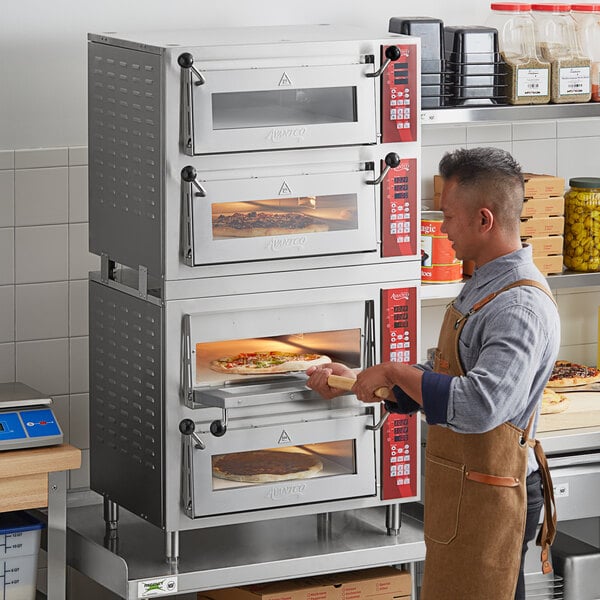
Multi-cook ovens are advanced commercial cooking appliances designed to prepare multiple dishes simultaneously at different temperatures, times, and cooking methods within the same unit. These ovens often feature separate cooking chambers or zones that operate independently, allowing chefs to bake, roast, grill, or steam various menu items without flavor transfer. Multi-cook ovens are ideal for high-volume kitchens, fast-casual restaurants, and establishments that require versatility and efficiency in limited spaces.
- Saves space by combining multiple cooking functions into one unit
- Streamlines the cooking process and reduces overall cooking times
- Performs a variety of cooking functions, including baking, roasting, grilling, and steaming
Where Should a Commercial Multi-Cook Oven Be Located?
The placement of a multi-cook oven should prioritize workflow and accessibility. Ideally, it should be positioned near prep stations and other primary cooking equipment to streamline operations. In a quick-service restaurant, place multi-cook ovens near assembly lines to minimize movement, while in larger kitchens they can be situated close to other high-use equipment, such as fryers or grills to centralize cooking operations.
Commercial Multi-Cook Oven Requirements
Multi-cook ovens typically have higher electrical demands due to their advanced features and multiple independent zones. This may require dedicated electrical circuits to ensure the kitchen's electrical system can provide consistent power.
Many multi-cook ovens feature smart controls, programmable cooking cycles, and connectivity for remote monitoring or diagnostics. Some units benefit from network connections for software updates or easier centralized monitoring.
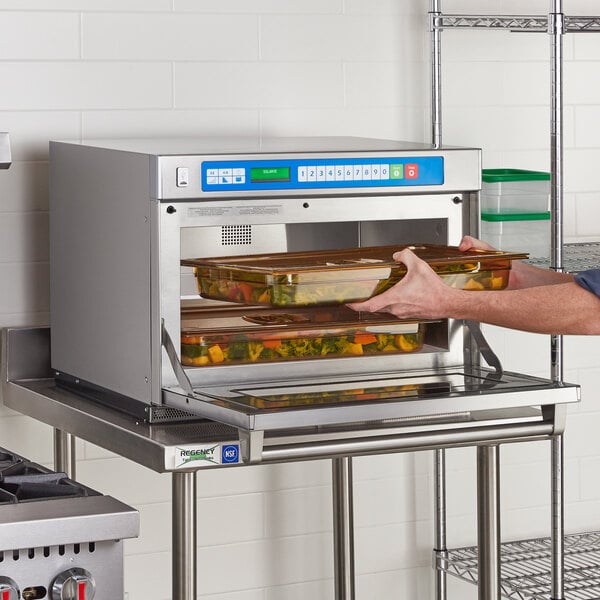
Microwave ovens are equipment that uses electromagnetic waves to rapidly heat or cook food. Unlike conventional ovens, microwaves work by causing water molecules in food to vibrate, generating heat from within. Commercial microwave ovens are designed for high-volume and heavy-duty use, offering faster cooking times and durability compared to residential models. They are commonly used for reheating, defrosting, and cooking pre-prepared items, making them essential in quick-service restaurants, cafes, and institutional kitchens.
- Known for their rapid cooking and heating capabilities
- Typically compact in size, making them ideal for kitchens with limited space
- Cost-effective and budget-friendly
Where Should a Commercial Microwave Oven Be Located?
A microwave oven should be placed near prep stations where reheating, defrosting, or quick cooking occurs frequently. Situate the microwave within arm’s reach of high-traffic areas like sandwich or salad assembly lines to minimize movement and speed up service. To ensure optimal performance, avoid placing the microwave directly next to other ovens, grills, or fryers, which may interfere with its operation due to heat or grease. Additionally, avoid placing the microwave near sensitive electronic equipment or devices that may be disrupted by electromagnetic interference.
Commercial Microwave Oven Requirements
Microwave ovens use electromagnetic waves for cooking, which necessitates regular inspection to ensure the microwave door seals are intact and free from damage and leaks. Commercial microwaves must also meet strict food safety standards that may not apply to residential models, such as requiring NSF Certification.
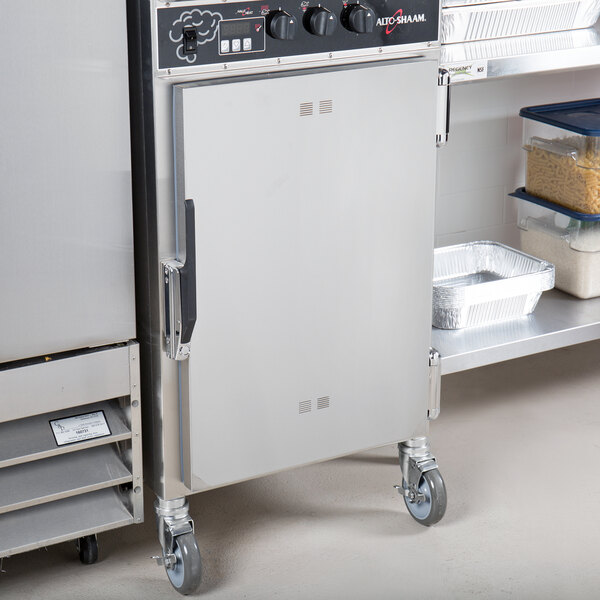
Indoor smoker ovens are specialized cooking appliances designed to infuse food with rich, smoky flavors while cooking it to perfection. These ovens are equipped with smoke-generating mechanisms that use wood chips, pellets, or other smoking mediums, allowing chefs to prepare smoked meats, seafood, vegetables, and even cheeses indoors.
Unlike traditional outdoor smokers, indoor smoker ovens are designed for enclosed environments, featuring controlled temperature settings and ventilation systems to manage smoke and heat safely. They are ideal for restaurants, barbecue joints, and catering kitchens that want to offer authentic smoked dishes year-round.
- Achieves authentic smoky flavor without the need for an outdoor smoker
- Adjustable temperature and smoke levels for precise cooking results
- Can also be used for baking, roasting, and other cooking methods
Where Should a Commercial Indoor Smoker Oven Be Located?
To minimize safety hazards, place the oven in a low-traffic area of the kitchen, as opening the smoker may release heat or residual smoke. Indoor smoker ovens must be installed near or under an appropriate hood system to handle smoke exhaust effectively, ensuring compliance with local codes.
Commercial Indoor Smoker Oven Requirements
A commercial-grade hood system is typically required to manage smoke and odors produced during operation. Ensure the hood complies with local fire and air quality regulations. You will also need the proper ductwork with grease traps or filters to minimize fire hazards from smoke and grease-laden vapors.
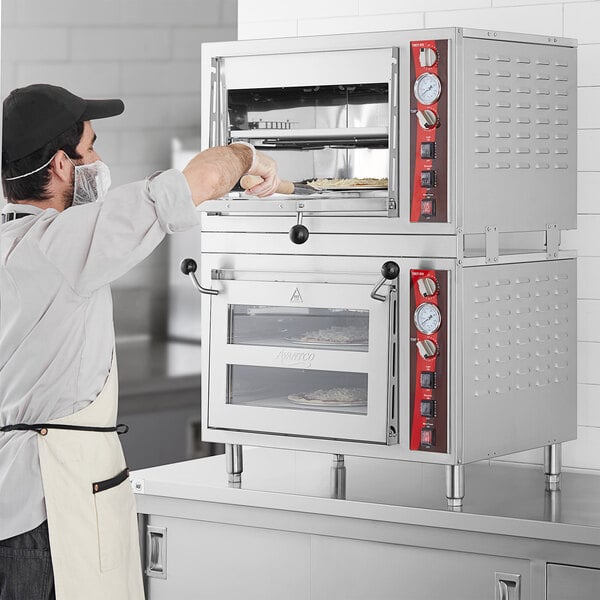
Bakery deck ovens are specialized ovens designed for baking high-quality breads, pastries, and other baked goods. They feature individual baking chambers, or "decks," each with independent temperature controls and are often equipped with stone or ceramic surfaces for even heat distribution. This design allows bakers to produce consistent results, with a focus on achieving crusty textures and artisan finishes. Deck ovens are especially valued in bakeries, patisseries, and pizza kitchens for their ability to handle large volumes while maintaining superior baking quality.
- Allows you to bake different products simultaneously
- High-capacity
- Durable and long-lasting
Where Should a Commercial Bakery Deck Oven Be Located?
You'll want to position your bakery deck oven close to areas where dough is mixed, shaped, or proofed to minimize the time and effort required to transfer items to the oven. In addition, you should place the oven near cooling racks and packaging stations for efficient movement of baked goods post-baking. Avoid placing the oven near dishwashers, steamers, or other high-humidity equipment that may affect dough rising or baking performance.
Commercial Bakery Deck Oven Requirements
Bakery deck ovens, particularly multi-deck models, are heavier than most commercial ovens, requiring heavy, level floors for support. If your bakery deck oven includes a steam injection feature, verify you have a dedicated water line for steam functionality and proper surrounding drainage for handling steam condensation.
Commercial Oven Purchasing Considerations
When considering purchasing a commercial oven for your foodservice establishment, there are several key factors to consider to ensure you select the right equipment for your establishment's needs. Below we've listed some important purchasing considerations to account for to guide your decision-making process:
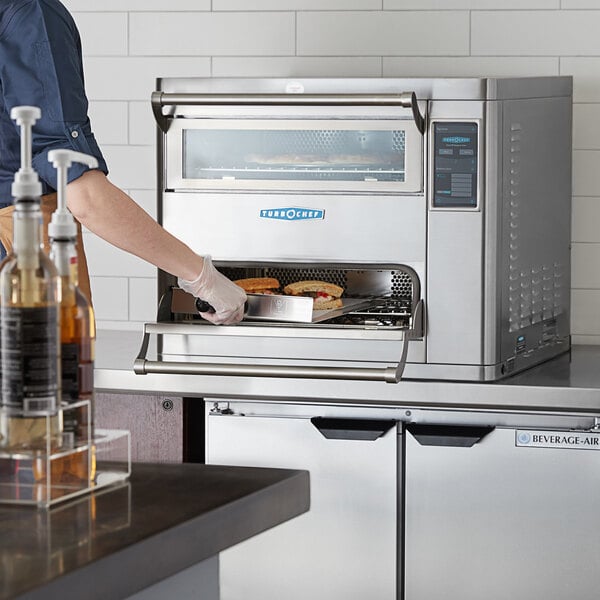
- Type of Commercial Oven - Commercial ovens come in various types, including convection ovens, deck ovens, conveyor ovens, and combination ovens. Each type has its unique features and benefits, so it's essential to choose the one that best suits your menu and cooking requirements.
- Size and Capacity - The size and capacity of the commercial oven are crucial factors to consider. Determine the amount of food you need to cook at once and the available space in your kitchen to select an appropriately-sized oven that can handle your cooking volume efficiently.
- Energy Efficiency - If you're searching for a way to reduce operating costs and environmental impact, opt for an energy-efficient commercial oven. Look for ovens with features such as insulated walls, efficient heating elements, and programmable settings to maximize energy savings.
- Ventilation Requirements - Ensure your kitchen has proper ventilation to accommodate the commercial oven's exhaust requirements. Proper ventilation is essential for maintaining air quality, preventing overheating, and complying with safety regulations.
- Budget and Cost - Set a budget for your commercial oven purchase and consider the overall cost, including installation, maintenance, and energy expenses. Balance your budget with the features and quality of the oven to make a cost-effective investment for your business.
- Ease of Use and Cleaning - Look for commercial ovens that are user-friendly and easy to clean to streamline your kitchen operations. Features such as programmable controls, digital displays, and removable parts for cleaning can enhance the efficiency and maintenance of the oven.
Related Resources

December 2025 WebstaurantStore Coupon Code
The holiday season is here, and during December you can find amazing deals on important items here at WebstaurantStore for the upcoming season. We're offering great sales all month long, with deals ranging from essential restaurant beverage equipment to themed take-out supplies for your festive creations. Check out our selection of sale items below and don't forget to enter the code WINTER25 at checkout to enjoy savings of up to 10%! Looking to save even more? Check out the new Webstaurant Rewards® Visa Business Card ! Sign up for a new card today and start earning rewards on every WebstaurantStore purchase, and save on a WebstaurantPlus subscription. Explore incredible deals on festive disposable items with December's monthly coupon code!
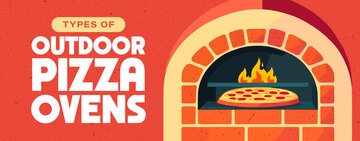
Outdoor Pizza Ovens Buying Guide
A staple piece of equipment for your outdoor kitchen setup is the addition of an outdoor pizza oven. In addition to baking delicious pizza, these versatile ovens can bake bread, desserts, meats, and vegetables. Given the popularity of pizza, an outdoor pizza oven is a perfect item to add to your equipment list for your pizzeria , food truck, or catering service. Below are details on the different types of outdoor pizza ovens, fuels, sizes, and accessories. Shop All Commercial Outdoor Pizza Ovens

How to Clean a Kitchen Hood
Kitchen hoods are a key part of any restaurant, helping to ventilate your workplace and remove hazardous particles from the air. Because of their importance in the kitchen, keeping your hood systems in working condition is imperative to your safety and success. Along with regular maintenance checks, making an effort to keep your hoods clean can help to ensure they stay in working condition. If you're unfamiliar with how to clean a kitchen hood, this article will teach you how to do it properly. Commercial Hood Cleaning Keeping your kitchen hoods clean is an important way to maintain a healthy, safe, and functional workplace. If grease or other contaminants are allowed to build up in your hood system, you may experience an increased risk of

